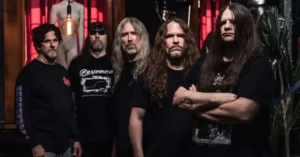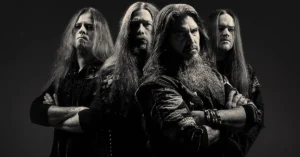Diamond Head: The Unsung Architects of Thrash and Heavy Metal
Diamond Head. Forged in Steel: Formation and NWOBHM Origins (1976–1980)
Diamond Head formed in Stourbridge, England, in 1976, at the very heart of the West Midlands — a region often considered the birthplace of heavy metal. The founding members were:
- Brian Tatler – guitar
- Sean Harris – vocals
- Duncan Scott – drums
- Colin Kimberley – bass
Influenced by Led Zeppelin, Black Sabbath, and Deep Purple, the band mixed heavy riffs with melodic flair and technical guitar work. They quickly became one of the leaders of the New Wave of British Heavy Metal (NWOBHM), alongside Iron Maiden and Saxon.
Diamond Head. The Lightning to Come: Early Demos and Cult Stardom
In 1980, Diamond Head released their debut album independently:
Lightning to the Nations (1980)
Also known as The White Album due to its plain white cover, this raw, explosive record became a blueprint for thrash metal. Tracks like:
- “Am I Evil?”
- “The Prince”
- “Helpless”
- “Sucking My Love”
…combined sharp riffs, galloping rhythms, and epic song structures. Though distribution was limited at first, the album’s underground success made it a cult classic.
Diamond Head. Influence on Metallica and the Thrash Scene
Diamond Head’s biggest claim to fame lies in the bands they inspired, particularly Metallica, who covered four of their songs:
- “Am I Evil?”
- “The Prince”
- “Helpless”
- “It’s Electric”
Metallica’s 1984 B-side release of “Am I Evil?” brought Diamond Head’s music to an international audience and solidified their reputation as one of thrash metal’s godfathers.
Chasing the Mainstream: Borrowed Time & Canterbury (1982–1983)
With a rising profile, Diamond Head signed to MCA Records and released:
Borrowed Time (1982)
With better production and artwork by Rodney Matthews, this album aimed for commercial success. Tracks like:
- “In the Heat of the Night”
- “Call Me”
- Re-recordings of “Am I Evil?” and “Lightning to the Nations”
…reflected a more polished, epic style. It charted in the UK and brought the band on major tours, including a support slot for AC/DC.
Canterbury (1983)
An ambitious, progressive, and softer album with orchestral elements. Songs like “Knight of the Swords” showed musical range, but fans and critics were divided. The album’s stylistic shift and pressing delays led to poor sales, and Diamond Head lost momentum.
Disbandment and Brief Reformations (1984–1993)
Frustrated by commercial challenges and label conflicts, the band broke up in 1985. Brian Tatler attempted a short-lived revival in 1990 with vocalist Pete Vuckovic, releasing the “Sweet and Innocent” EP and working on demos.
Metallica’s Boost and the 1993 Reunion
Metallica’s consistent praise reignited interest in Diamond Head, especially after Metallica included “Am I Evil?” on 1998’s Garage Inc. compilation.
In 1993, the original lineup reunited, performing live and re-recording early songs on the Death and Progress (1993) album, which featured guest appearances by Tony Iommi and Dave Mustaine.
Diamond Head. Lineup Changes and a New Era (2000s–2010s)
From the late 1990s into the 2000s, Brian Tatler remained the core member, leading several new lineups:
All Will Be Revealed (2005)
With Nick Tart on vocals, this album was a modern attempt at hard rock/metal, but divided long-time fans.
What’s in Your Head? (2007)
Heavier than its predecessor, but still a departure from the classic NWOBHM sound.
Rebirth with Rasmus Bom Andersen (2014–present)
In 2014, Danish-born vocalist Rasmus Bom Andersen joined, ushering in a new chapter that returned to the band’s roots.
Diamond Head (2016)
A triumphant return to form, combining classic NWOBHM style with modern energy. Songs like “Bones” and “Shout at the Devil” showcased strong songwriting and revitalized energy.
The Coffin Train (2019)
Critically acclaimed for its dynamic production and maturity. Tracks like “Death by Design” and “The Sleeper” captured the band’s original power, infused with modern heaviness.
Diamond Head. Legacy and Influence
Despite commercial struggles, Diamond Head’s influence far exceeds their chart success. Their hallmarks:
- Tight, melodic riffs
- Epic song structures
- Thrash-level intensity before thrash existed
They are often cited alongside Motörhead, Venom, and Saxon as foundational forces in the development of thrash and speed metal.
Major bands citing them as an influence:
Full Studio Discography
- Lightning to the Nations (1980)
- Borrowed Time (1982)
- Canterbury (1983)
- Death and Progress (1993)
- All Will Be Revealed (2005)
- What’s in Your Head? (2007)
- Diamond Head (2016)
- The Coffin Train (2019)
Interesting Facts
- Metallica’s live performances of “Am I Evil?” have introduced Diamond Head to millions of fans worldwide.
- Despite early obscurity, Diamond Head is now recognized as a crucial missing link between classic metal and thrash.
- Brian Tatler joined Saxon on stage in 2022 — a reunion of NWOBHM pioneers.
- Tatler is now also part of Venom Inc., showcasing his continued relevance in extreme metal.
Final Thoughts
Diamond Head might not have reached the same commercial peaks as some of their peers, but their influence is carved deep into the foundations of modern metal. Their ability to mix melodic sensibility with crushing heaviness makes them a vital band for anyone exploring the origins of thrash, speed, and heavy metal. With a new lineup that respects the past while pushing forward, Diamond Head continues to prove their enduring fire.





